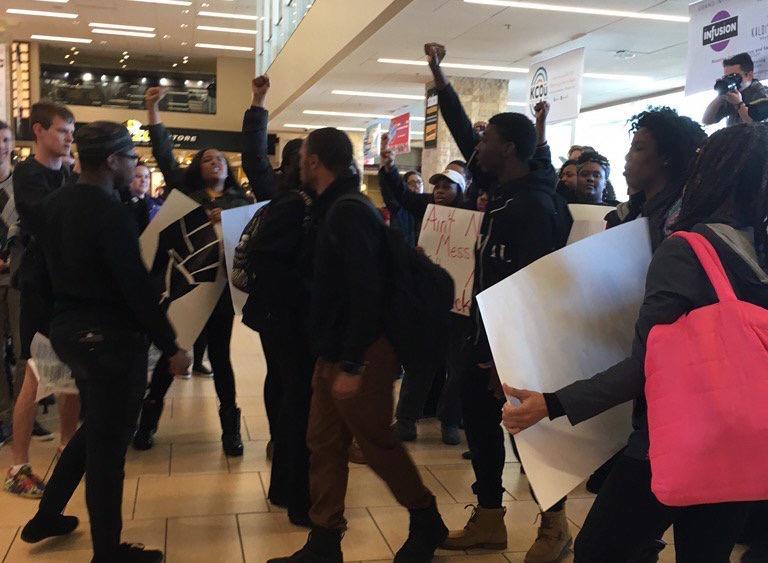
When a group of protesters interrupted the UM System Board of Curators meeting Thursday afternoon, Chairwoman Pamela Henrickson banged the gavel several times to call for order, but eventually fell silent.
In their first protest of the semester, Concerned Student 1950 activists spoke out on many of the same issues of racism they had focused on previously. Protesters marched through the Student Center and spoke to a tour group at Speakers Circle. When they reached the Board of Curators meeting, a student read [the group’s demands](https://www.themaneater.com/stories/2015/11/4/mizzou-fails-fully-meet-demands/) to the room.
Initially, the activists stood outside the room while they spoke, but the curators were not actually in the room yet. The group reconvened downstairs in the Alumni Center and then returned when the curators entered public session.
While the resignation of UM System President Tim Wolfe satisfied part of the group’s stipulations, other demands have not been met. In their [press conference after his resignation](https://www.themaneater.com/stories/2015/11/9/concerned-student-1950-issues-new-demands/), the group had said that they would continue to work until those demands were met “in totality.”
Concerned Student 1950 activists still await a handwritten apology note from Wolfe. They want it to include an acknowledgement of his “white male privilege,” recognition of the existence of systems of oppression and apologies for allowing his driver to bump into a protester and for not intervening when the Columbia Police Department used what they deemed excessive force in breaking up the demonstration.
Activists have also called for a system of “shared governance” where a diverse board of students and faculty deliver input on the selection of the next UM System president. Concerned Student 1950 tweeted after the protest that the curators had told them students would be included in the search.
@umcurators chair verbally confirms with fellow member that students will be on search committee team #PresidentalSearch #NewTradition
— ConcernedStudent1950 (@CS_1950) February 3, 2016
Activists have also asked that administrators meet the Legion of Black Collegians’ [original 1969 demands](https://diversity.missouri.edu/timeline/lbc-demands-universityarchives74.pdf). LBC also demanded more black faculty and provisions such as a campus-wide academic bankruptcy program. Some LBC demands have been met, such as the establishment of the Gaines/Oldham Black Culture Center and the Department of Black Studies.
After reviewing their past unmet demands, protesters also spoke on why they stood with assistant professor of communications Melissa Click.
Click received national attention when student journalist Mark Schierbecker filmed her grabbing at his camera and calling for “muscle” to remove him from the Concerned Student 1950 campsite following Wolfe’s resignation Nov. 9.
Curators [suspended Click](https://www.themaneater.com/stories/2016/1/27/melissa-click-suspended-um-system-board-curators-p/) from the university Jan. 27 after she was charged with third-degree assault for her actions. She [reached a deal](https://www.themaneater.com/stories/2016/1/30/melissa-click-reaches-deal-city-prosecutor/) with City Prosecutor Stephen Richey to avoid prosecution in exchange for 20 hours of community service and no further violations.
[Several petitions have circulated](https://www.themaneater.com/stories/2015/11/10/petitions-started-remove-two-mu-employees-after-in/) calling for Click’s removal. A Facebook community titled “Hey Hey Ho Ho Melissa Click Has Got to Go” has over 1,300 likes.
In contrast, many faculty members and students have since [spoken out](https://www.themaneater.com/stories/2016/1/5/missouri-republicans-ask-curators-fire-professor-m/) in her support. Over 100 faculty members signed a letter calling her “an ally to students who were protesting what they saw as their exclusion from and isolation at the University.”
Activists cited Click’s support for the Concerned Student cause as reason for their support of her.
“Melissa Click has something different about her than anybody else I’ve met at the university for the most part,” one protester said. “She’s seen me as one full person, not a black girl, not a little ghetto girl, not three-fifths a person, but a person.”
They also contrasted Click’s response to the movement with the curators’.
“I stand with Melissa Click because she’s not the problem,” one activist said. “You all sitting here and not doing anything is the problem. Melissa Click made sure we were okay when no one in this room did. Melissa Click isn’t the problem. You are.”
Activists once again brought up the conflict between journalists and protesters at the campsite. They said Click had protected them from “abusive” journalists who were trying to profit from their struggle.
“Melissa Click understands that liberation is not a paycheck or a deadline,” an activist said.
Confrontations similar to those from the original campsite occurred during the protest. Activists blocked a reporter with signs outside the Alumni Center and asked media to leave when they entered the Multicultural Center at the end of the protest. Unlike the original confrontation between Click and Schierbecker, no threats of physical removal were made.
Schierbecker, who also attended the protest, became involved in a confrontation with protesters again when one raised a sign to block his view inside the Multicultural Center. Schierbecker began filming the activist on his phone, and another responded by filming him in turn.
“I’m just trying to make sure it’s safe,” he told the activist filming him.
“Just leave him alone,” another protester told her. To Schierbecker, she said, “You’re fine as long as you don’t get too pushy.”
The protesters left Schierbecker and returned to the Multicultural Center.
During their march, several passing students made remarks to the activists. One said, “Oh my god, just shut up,” and another yelled, “assault!” when he and a protester bumped into each other. Both times, activists reminded each other to “not engage.”
Protesters reiterated the message from previous [“racism lives here” protests](https://www.themaneater.com/stories/2015/9/25/protest-reminds-students-faculty-racism-lives-here/), where activists asked bystanders to take a more active role in combatting campus racism. Many of the initial demands from the “Racism Lives Here” protests before the formation of Concerned Student 1950, such as more funding for the the counseling center, have still not been met.
“We love this university, which is why we are so critical of this university,” an activist told bystanders in the Student Center. “White supremacy exists here. Racism exists here. And we exist here.”